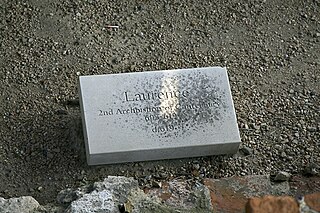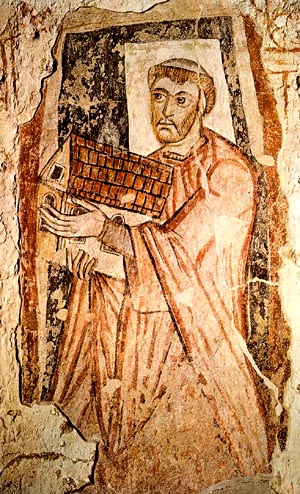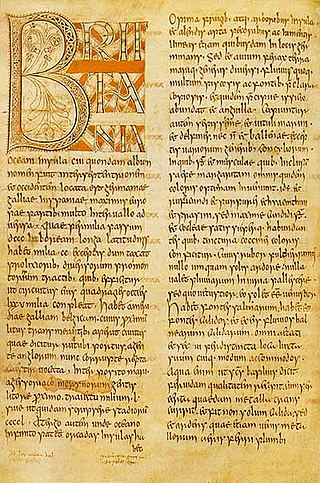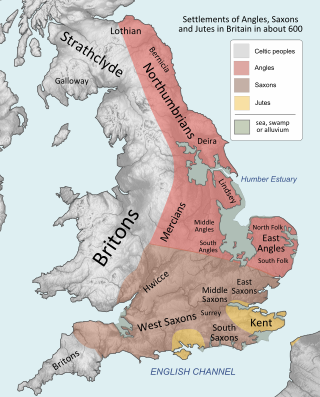External links
- Hadrian 2 at Prosopography of Anglo-Saxon England
- CatholicSaints.Info Adrian of Canterbury
- Catholic Online Saints and Angels St Adrian
| International | |
|---|---|
| National | |
| People | |
| Other | |
Adrian of Canterbury | |
|---|---|
| Abbot | |
| Born | between 630–637 |
| Died | 709/710 |
| Venerated in | Eastern Orthodox Church, Catholic Church, Anglican Church |
| Feast | 9 January |
Adrian, also spelled Hadrian (born before 637, died 710), was a North African scholar in Anglo-Saxon England and the abbot of Saint Peter's and Saint Paul's in Canterbury. He was a noted teacher and commentator of the Bible. [1] Adrian was born between 630 and 637. [1] According to Bede, he was "by nation an African", [2] and thus a Berber [3] [4] native of North Africa, and was abbot of a monastery near Naples, called Monasterium Niridanum (perhaps a mistake for Nisidanum, as being situated on the island of Nisida).
He was twice offered the vacant archbishopric of Canterbury, by Pope Vitalian, but modestly declined the appointment. He first recommended that it should be given to Andrew, a monk belonging to a neighbouring monastery (monachum quemdam de vicino virginum monasterio), who also declined on the plea of advanced years. Then, when the offer was again made to Adrian, he introduced to the pontiff his friend Theodore of Tarsus, who then chanced to be at Rome, and who consented to undertake the charge. Vitalian, however, stipulated that Adrian should accompany the new archbishop to Britain. He gave as his reasons that Adrian, having twice before made a journey into Gaul, knew the road and the mode of travelling.
The two set out from Rome on 27 May 668, and proceeding by sea to Marseille, crossed the country to Arles, where they remained with John, the archbishop, till they got passports from Ebroin, who ruled that part of Gaul as Mayor of the Palace, for the minor king Clotaire III. Having then made their way together to the north of France, they parted company, and went severally to reside for the winter, Theodore with Agilbert, bishop of Paris, Adrian first with Emmon, bishop of Sens, and afterwards with Faro, bishop of Meaux. Theodore, being sent for in the following spring by King Ecgberht of Kent, was allowed to take his departure, and he reached England at the end of May 669; but Adrian was detained by order of Ebroin, who is said to have suspected him of being an emissary of the Greek emperor sent to stir up troubles against the kingdom of the Franks.
At length, however, the tyrant became convinced that there was no ground for this notion, and Adrian was permitted to proceed to England, where, immediately on his arrival, he was made abbot of the monastery of Saints Peter and Paul (afterwards called Saint Augustine's) at Canterbury, an appointment which was in conformity with instructions given by the pope to Theodore. Such is the account given in the Ecclesiastical History (iv. 1.). Adrian was known to be a man learned in the Bible, as well as in Greek and Latin, and an excellent administrator. Under his direction the abbey came to have substantial, far-reaching influence.
In another account, also attributed to Bede, in his Lives of the Abbots of Wearmouth, it is stated that Adrian was not made abbot till after the resignation of Benedict Biscop, who is made to have accompanied Theodore all the way from Rome, and to have been immediately on their arrival appointed to this place, which he appears to have held for about two years. The facts in the two relations are not perhaps absolutely irreconcilable; but they are strangely dissimilar in manner, and in the circumstances which they respectively notice, to have come from the same pen.
Bede describes Adrian (or Hadrian, as he calls him in the Ecclesiastical History), as not only a distinguished theologian, but eminently accomplished in secular learning; he and Theodore, we are told, traversing all parts of the island, gathered multitudes of scholars around them wherever they appeared, and employed themselves daily with equal diligence and success in instructing those who flocked to them not only in the truths of religion but in the several branches of science and literature then cultivated. Bede particularly mentions the metrical art, astronomy, and arithmetic (which may be considered as representing what we should now call rhetoric and the belles lettres, physical science, and mathematics); and he adds, that while he wrote (in the early part of the eighth century), there still remained some of the pupils of Theodore and Adrian, who spoke the Greek and Latin languages as readily as their native tongue. A record of the teaching of Theodore and Adrian is preserved in the Leiden Glossary . [5]
To the flourishing state of learning thus introduced into England, and for a short time maintained, King Alfred appears to allude in the preface to his translation of Pope Gregory I's Liber Pastoralis Curae, in the latter part of the ninth century, where he says that it often came into his mind what wise men there were in the country, both laymen and ecclesiastics, in a former age; how the clergy in those happy times were diligent both to teach and to study, and how foreigners then came hither to acquire learning and wisdom; whereas now, in his own day, if any Englishman desired to make himself a scholar, he was obliged to go abroad for instruction.
Adrian, long surviving his friend the archbishop, is said to have lived for 39 years after he came to England, continuing till his death to preside over the monastery at Canterbury. (Bede, Historia ecclesiastica gentis Anglorum iv. 1, 2.; and Vita Abbatum Wiramuth., in Smith's Beda, p. 293.; W. Malmes. De Pontif. p. 340.) He died in 709 and was buried in his monastery. He came to be regarded as a saint and his relics were re-deposited in the new monastery on 9 January 1091, which is now his feast day. [1]

Augustine of Canterbury was a Christian monk who became the first archbishop of Canterbury in the year 597. He is considered the "Apostle to the English”.

Bede, also known as Saint Bede, the Venerable Bede, and Bede the Venerable, was an English monk and an author and scholar. He was one of the greatest teachers and writers during the Early Middle Ages, and his most famous work, Ecclesiastical History of the English People, gained him the title "The Father of English History". He served at the monastery of St Peter and its companion monastery of St Paul in the Kingdom of Northumbria of the Angles.

Justus was the fourth Archbishop of Canterbury. Pope Gregory the Great sent Justus from Italy to England on a mission to Christianize the Anglo-Saxons from their native paganism, probably arriving with the second group of missionaries despatched in 601. Justus became the first Bishop of Rochester in 604 and attended a church council in Paris in 614.

Laurence was the second Archbishop of Canterbury, serving from about 604 to 619. He was a member of the Gregorian mission sent from Italy to England to Christianise the Anglo-Saxons from their native Anglo-Saxon paganism, although the date of his arrival is disputed. He was consecrated archbishop by his predecessor, Augustine of Canterbury, during Augustine's lifetime, to ensure continuity in the office. While archbishop, he attempted unsuccessfully to resolve differences with the native British bishops by corresponding with them about points of dispute. Laurence faced a crisis following the death of King Æthelberht of Kent, when the king's successor abandoned Christianity; he eventually reconverted. Laurence was revered as a saint after his death in 619.
Mellitus was the first bishop of London in the Saxon period, the third Archbishop of Canterbury, and a member of the Gregorian mission sent to England to convert the Anglo-Saxons from their native paganism to Christianity. He arrived in 601 AD with a group of clergy sent to augment the mission, and was consecrated as Bishop of London in 604. Mellitus was the recipient of a famous letter from Pope Gregory I known as the Epistola ad Mellitum, preserved in a later work by the medieval chronicler Bede, which suggested the conversion of the Anglo-Saxons be undertaken gradually, integrating pagan rituals and customs. In 610, Mellitus returned to Italy to attend a council of bishops, and returned to England bearing papal letters to some of the missionaries.

Aldhelm, Abbot of Malmesbury Abbey, Bishop of Sherborne, and a writer and scholar of Latin poetry, was born before the middle of the 7th century. He is said to have been the son of Kenten, who was of the royal house of Wessex. He was certainly not, as his early biographer Faritius asserts, the brother of King Ine. After his death he was venerated as a saint, his feast day being the day of his death, 25 May.
Theodore of Tarsus was Archbishop of Canterbury from 668 to 690. Theodore grew up in Tarsus, but fled to Constantinople after the Persian Empire conquered Tarsus and other cities. After studying there, he relocated to Rome and was later installed as the Archbishop of Canterbury on the orders of Pope Vitalian. Accounts of his life appear in two 8th-century texts. Theodore is best known for his reform of the English Church and establishment of a school in Canterbury.
Wilfrid was an English bishop and saint. Born a Northumbrian noble, he entered religious life as a teenager and studied at Lindisfarne, at Canterbury, in Francia, and at Rome; he returned to Northumbria in about 660, and became the abbot of a newly founded monastery at Ripon. In 664 Wilfrid acted as spokesman for the Roman position at the Synod of Whitby, and became famous for his speech advocating that the Roman method for calculating the date of Easter should be adopted. His success prompted the king's son, Alhfrith, to appoint him Bishop of Northumbria. Wilfrid chose to be consecrated in Gaul because of the lack of what he considered to be validly consecrated bishops in England at that time. During Wilfrid's absence Alhfrith seems to have led an unsuccessful revolt against his father, Oswiu, leaving a question mark over Wilfrid's appointment as bishop. Before Wilfrid's return Oswiu had appointed Ceadda in his place, resulting in Wilfrid's retirement to Ripon for a few years following his arrival back in Northumbria.

Benedict Biscop, also known as Biscop Baducing, was an Anglo-Saxon abbot and founder of Monkwearmouth-Jarrow Priory and was considered a saint after his death.
Ecgberht I was a king of Kent (664-673), succeeding his father Eorcenberht.

Aldfrith was king of Northumbria from 685 until his death. He is described by early writers such as Bede, Alcuin and Stephen of Ripon as a man of great learning. Some of his works and some letters written to him survive. His reign was relatively peaceful, marred only by disputes with Bishop Wilfrid, a major figure in the early Northumbrian church.

The Ecclesiastical History of the English People, written by Bede in about AD 731, is a history of the Christian Churches in England, and of England generally; its main focus is on the conflict between the pre-Schism Roman Rite and Celtic Christianity. It was composed in Latin, and is believed to have been completed in 731 when Bede was approximately 59 years old. It is considered one of the most important original references on Anglo-Saxon history, and has played a key role in the development of an English national identity.
Nothhelm was a medieval Anglo-Saxon Archbishop of Canterbury. A correspondent of both Bede and Boniface, it was Nothhelm who gathered materials from Canterbury for Bede's historical works. After his appointment to the archbishopric in 735, he attended to ecclesiastical matters, including holding church councils. Although later antiquaries felt that Nothhelm was the author of a number of works, later research has shown them to be authored by others. After his death he was considered a saint.
Berhtwald was the ninth Archbishop of Canterbury in England. Documentary evidence names Berhtwald as abbot at Reculver before his election as archbishop. Berhtwald begins the first continuous series of native-born Archbishops of Canterbury, although there had been previous Anglo-Saxon archbishops, they had not succeeded each other until Berhtwald's reign.

Tatwine was the tenth Archbishop of Canterbury from 731 to 734. Prior to becoming archbishop, he was a monk and abbot of a Benedictine monastery. Besides his ecclesiastical career, Tatwine was a writer, and riddles he composed survive. Another work he composed was on the grammar of the Latin language, which was aimed at advanced students of that language. He was subsequently considered a saint.
Wighard was a medieval Archbishop-elect of Canterbury. What little is known about him comes from 8th-century writer Bede, but inconsistencies between various works have led to confusion about the exact circumstances of Wighard's election and whether he was ever confirmed in that office. What is clear is that he died in Rome after travelling there for confirmation by the papacy of his elevation to the archbishopric. His death allowed Pope Vitalian to select the next archbishop from amongst the clergy in Rome.

In the seventh century the pagan Anglo-Saxons were converted to Christianity mainly by missionaries sent from Rome. Irish missionaries from Iona, who were proponents of Celtic Christianity, were influential in the conversion of Northumbria, but after the Synod of Whitby in 664, the Anglo-Saxon church gave its allegiance to the Pope.

Nisida is a volcanic islet of the Flegrean Islands archipelago, in southern Italy. It lies at a very short distance from Cape Posillipo, just north of Naples; it is now connected to the mainland by a stone bridge. The islet is almost circular, with a flooded crater forming the bay of Porto Paone on the southwest coast. It has a diameter of about 0.5 kilometres and a highest altitude of 105 metres.

The Gregorian mission or Augustinian mission was a Christian mission sent by Pope Gregory the Great in 596 to convert Britain's Anglo-Saxons. The mission was headed by Augustine of Canterbury. By the time of the death of the last missionary in 653, the mission had established Christianity among the southern Anglo-Saxons. Along with the Irish and Frankish missions it converted Anglo-Saxons in other parts of Britain as well and influenced the Hiberno-Scottish missions to continental Europe.